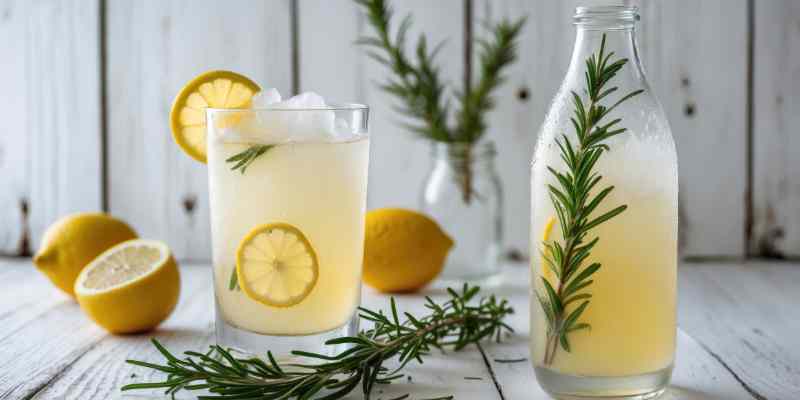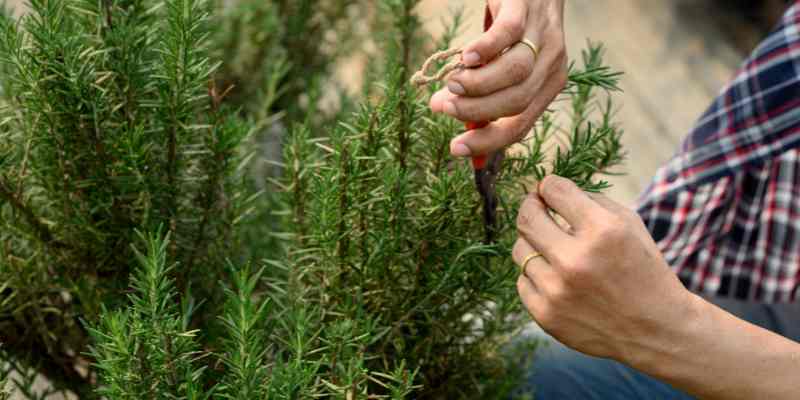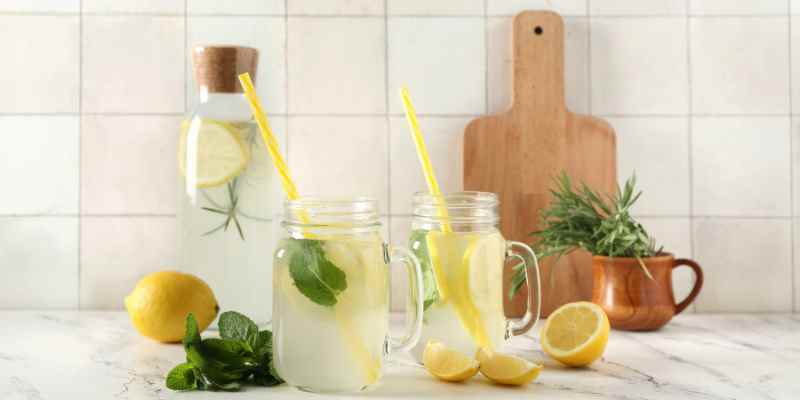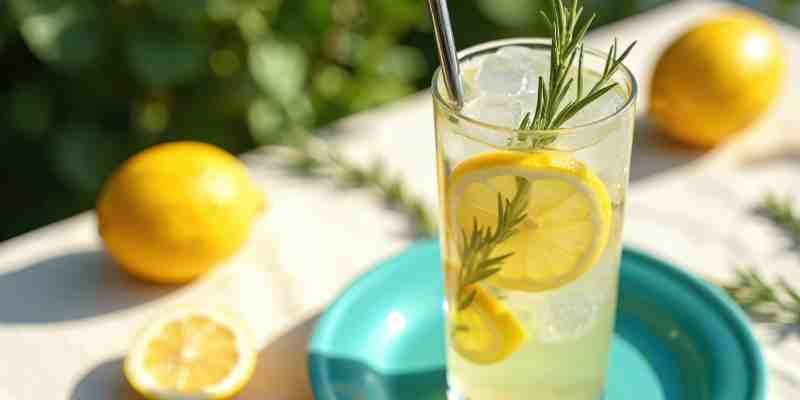Fancy a sparkling drink that’s slightly wild and full of freshness? Rosemary lemonade, or rosemary sparkling drink, is a homemade fermented beverage that combines the freshness of lemon with the aromatic power of rosemary. Naturally effervescent due to fermentation, this homemade lemonade is an excellent alternative to industrial sodas, free from additives and preservatives. This drink with fine bubbles offers a unique and invigorating taste, slightly tangy, perfect for hot days or summer aperitifs. Discover how to prepare this sparkling rosemary lemonade, from harvesting the rosemary to bottling it.

Lemonade or rosemary sparkling drink?
The term lemonade is quite generic. It traditionally refers to a sweet, lemon-based drink, and sometimes fizzy — either by adding carbon dioxide in industrial versions or through natural fermentation in artisanal recipes, like the one proposed here.
In contrast, the term rosemary sparkling drink is more specific. It highlights the aromatic character of rosemary, the main ingredient in the recipe, as well as the fact that the effervescence is achieved naturally through a fermentation process.
In this tutorial, whether we refer to fermented lemonade or rosemary sparkling drink, it is essentially the same beverage: a homemade, aromatic, and thirst-quenching preparation.
When and how to harvest rosemary?
Rosemary (Rosmarinus officinalis) is a persistent Mediterranean shrub, meaning it retains its leaves all year round. Easy to grow in pots or in the ground, it is valued for both its hardiness and its powerful aroma in cooking and infusions.
Harvesting can be done at any time of the year, but the ideal period is in spring and summer when the plant is in full growth and the branches are well stocked with essential oils. For maximum flavour, it is best to pick in the late morning, on a dry day, after the dew has evaporated. Take young, flexible stems without weakening the plant: always cut above a node to encourage regrowth.
For fermented rosemary lemonade, using fresh rosemary is highly recommended. It offers a more intense aroma than dried rosemary and can naturally promote fermentation due to the wild yeasts present on the surface of the leaves. Dried rosemary can be a backup, but the taste will often be less vibrant, and the fermenting effect may be slower or uncertain. For a sparkling, fragrant, and successful drink, it is therefore advisable to use fresh branches.

Recipe for rosemary sparkling drink
Ingredients:
- A generous handful of fresh rosemary, just picked
- 1 litre of pure, filtered water
- 100 g of unrefined sugar (such as whole cane sugar or light brown sugar)
- The juice of one organic lemon
- 2 thin slices of organic lemon
Necessary equipment:
- 1 glass jar and a glass bottle with an airtight seal (like artisanal lemonade or certain beer bottles) that can withstand pressure. You can also use sturdy screw-top bottles.
- 1 funnel
- 1 strainer
- 1 clean cloth or muslin
Preparation of rosemary lemonade
- Gently clean the rosemary without rinsing it under running water to preserve the natural yeasts on its leaves. Simply shake the stems to remove any dust or potential insects.
- In the sterilised large jar, pour in the water.
- Then add the sugar and stir well until completely dissolved.
- Incorporate the freshly squeezed lemon juice, followed by the slices of organic lemon.
- Finally, add the handful of fresh rosemary directly into the mixture.
- Cover the jar with a clean cloth or muslin, secured with an elastic band, and let it ferment at room temperature for 2 to 4 days. Taste daily to monitor the progress.
- Once the drink becomes slightly sparkling and tangy, strain and transfer to an airtight glass bottle, leaving about 2 to 3 cm of space below the neck.
- Optionally, leave it for an additional day in the bottle to enhance fermentation, then place in the refrigerator to slow down the fermentation of the homemade lemonade.

My tips: Over the days, you should observe some signs indicating that fermentation is underway: small bubbles rising to the surface, a slight foam may form, and the drink gradually becomes less sweet, with a gentle acidity reminiscent of a natural soda. It is important to taste daily to avoid over-fermentation. The longer you let it ferment, the more tangy, less sweet, and more sparkling the drink will be — but be careful, as this also increases the pressure in the bottles.
Variations
To mix things up, you can infuse fresh lavender sprigs (such as true lavender or common lavender, Lavandula angustifolia) with the rosemary for a floral version, add a few slices of fresh ginger for a more invigorating drink, or replace the sugar with honey for a sweeter and warmer lemonade.

Storing rosemary lemonade
Once the fermented lemonade is to your taste, it can be stored for up to two months in the refrigerator, provided it is well filtered and bottled properly. The carbonation continues gently in the cold, resulting in a more sparkling drink after one to two weeks. During this period, it is advisable to open the bottles every two to three days for just a few seconds to release excess pressure and prevent any overflow or explosion.
The benefits of rosemary lemonade
Beyond its refreshing and slightly tangy taste, this rosemary drink also offers several interesting benefits. Rosemary is known for its digestive, stimulating, and slightly antiseptic properties. It helps relieve mild digestive issues, stimulates circulation, and supports the liver.
Thanks to the natural fermentation, the homemade lemonade also becomes a living drink, a source of beneficial microorganisms for the gut flora, similar to kefirs or kombuchas.
































Comments